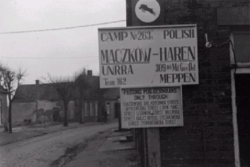Polish occupation zone in Germany facts for kids
Quick facts for kids Polish occupation zone in Germany
Polnische Besatzungszone Deutschlands
Polska strefa okupacyjna w Niemczech |
|||||||||
|---|---|---|---|---|---|---|---|---|---|
| Military occupation zone of the Polish government-in-exile part of Allied-occupied Germany | |||||||||
| 1945–1948 | |||||||||
| Capital | Maczków | ||||||||
| Area | |||||||||
|
• 1945
|
6,470 km2 (2,500 sq mi) | ||||||||
| Population | |||||||||
|
• 1945
|
48 000 | ||||||||
| • Type | Military occupation under administration of the Polish government-in-exile, within the British occupation zone in Germany | ||||||||
| Historical era | Post-World War II era Cold War |
||||||||
|
• Established
|
19 May 1945 | ||||||||
|
• Disestablished
|
10 September 1948 | ||||||||
|
|||||||||
| Today part of | Germany | ||||||||
The Polish occupation zone in Germany was a special area set up after World War II. It was managed by the Polish government-in-exile, which was a Polish government operating from outside Poland during the war. This zone was located inside the area of Germany controlled by the British army.
It existed from May 19, 1945, to September 10, 1948. The zone was created for Poles who had been forced to leave their homes during the war. Many of them were freed from German labor camps or concentration camps, or were former prisoners of war.
In 1945, about 30,000 Polish civilians and 18,000 soldiers lived there. The area was about 6,470 square kilometers (2,500 square miles). It was located in what is now Lower Saxony, Germany. The main town in this zone was Haren, which was renamed Maczków during this time.
Contents
A Special Place for Poles in Germany
After World War II ended, there were over 3 million Polish citizens in Germany. Most of these people were "displaced persons" (DPs). This meant they were far from home and couldn't easily return. They had been forced to work, or were held in German concentration camps or as prisoners of war.
Why Was It Created?
The situation in Poland was difficult because it was under Communist control. So, the Allied forces (like Britain and the US) decided to create a safe place for Poles in Germany. This area would be a temporary home and a cultural center. From here, Poles could decide to go back to Poland or move to other Western countries.
The town of Haren was chosen because it was in the area controlled by the Polish I Corps. This was a Polish army unit working with the British Army.
On May 19, 1945, the Polish 1st Armoured Division moved the German families living in Haren to nearby communities. Then, over 4,000 Poles moved into the town. Many of these Poles had fought in the Warsaw Uprising of 1944.
Life in Maczków
At first, the new Polish area was called Lwów. This was after a city in Poland that was taken over by the Soviet Union. But because of pressure from the Soviets, the name was changed to Maczków. This new name honored General Stanisław Maczek, who led the Polish Armoured Division.
The streets in Maczków were also given Polish names. Some honored military units, while others were named after streets in Warsaw.
Over the next few months, Maczków became a real Polish town. It had its own Polish mayor, a Polish school, and even a Polish fire brigade. There was also a Polish church where 289 weddings and 101 funerals were recorded. Many Polish babies were born there, with 479 birth certificates showing "Maczków" as their birthplace.
Maczków also became an important cultural center. Newspapers like Dziennik and Defilada were published daily. A theater was opened, led by a famous director named Leon Schiller. Concert halls were also active. Famous musicians like Benjamin Britten and Lord Yehudi Menuhin even performed there in 1947.
The End of the Zone
In the autumn of 1946, the Polish soldiers in Germany began to leave. They were sent back to the United Kingdom. Also, many Polish civilians started to return to Poland or move to other countries in Europe.
Finally, by the end of 1948, the town was given back to its original German residents. It was then renamed Haren again.



